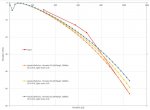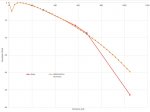I have an issue with back calculating bullet ballistics using several calculators (Applied Ballistics, Strelok, BallisticsARC, JMB Ballistics, Hornady 4DOF) from the DOPE I recently got.
Looking for some expert advice here but please be patient with me. My situation might be unique.
Let me start with the hardware:
1. .308 barrel, 24" long, 1:10 twist, muzzle brake
2. Hornady factory ELD Match ammo, 168gr bullet. Advertised BC of 0.523. Chrono'd with MagentoSpeed Sporter at 2668fps (70degF, 45% humidity, 28.91inHg, DA 1994ft). Pretty close to the specs on the box.
3. Sight height from bore: 2.375"
Weather:
32degF, press 28inHg, humidity 40%, DA 13 ft (yes, that low)
There was an average wind of 15MPH that day at 3 o'clock (but that shouldn't factor into the issue very much).
I got the chance to shoot a session at the ONLY long range in Michigan where I live. KD targets out to 1050yd. It's a hike and exclusive so I can't get there but a couple times per year for matches and no practice. So I used this chance to get some DOPE to take back and tweak the elevation marks I got from several ballistics calculators online and get a range card I could trust as a baseline for matches.
So I take the initial sight marks (come up, elevations, whatever u want to call them) and we are ok out to 675 yds, a little low given the weather but not a huge issue.
Then I try shooting the 1050 yard target. Bullet splash 50 yards IN FRONT of the target. After taking another 10 rounds and walking the shot to the target, the result is WAY off any calculator estimate.
Here's a twist that I hope won't lose folks from helping out. I use MOA.
So here goes the data download:
Almost any ballistics calculator tells me around 34MOA to get 1050yds at 70 degF.
Adjusting for conditions that day and sight scale factor with Applied Ballistics solver, I get a solution of at 44MOA.
The actual dial up was 53MOA! Verified with several shots.
It seems this combo of barrel and bullet results in a curve that goes exponential after 700yds. Well that ain't right I'm thinking.
So adjust the single BC in each calculator to tweak it closer to the 1050yd dial-up I got. Not surprising, as I lower the BC (down to 0.476, which might average out the high/med/low speed BC), the further away from shorter range DOPE recorded at the range that day. For those that are interested I attached a graph of the data with specs in the legend.
So my question is, what ballistics calculator with the right variables would help me with matching this actual DOPE data? Or what variable am I not accounting for?I can'r run out to the range and fingerprint this barrel every 25 yards under various conditions and need a ballistics calc that can help estimate elevations more accurately than the ones mentioned above.
Any advice is appreciated (aside from don't shoot a 308 for longer ranges).
Looking for some expert advice here but please be patient with me. My situation might be unique.
Let me start with the hardware:
1. .308 barrel, 24" long, 1:10 twist, muzzle brake
2. Hornady factory ELD Match ammo, 168gr bullet. Advertised BC of 0.523. Chrono'd with MagentoSpeed Sporter at 2668fps (70degF, 45% humidity, 28.91inHg, DA 1994ft). Pretty close to the specs on the box.
3. Sight height from bore: 2.375"
Weather:
32degF, press 28inHg, humidity 40%, DA 13 ft (yes, that low)
There was an average wind of 15MPH that day at 3 o'clock (but that shouldn't factor into the issue very much).
I got the chance to shoot a session at the ONLY long range in Michigan where I live. KD targets out to 1050yd. It's a hike and exclusive so I can't get there but a couple times per year for matches and no practice. So I used this chance to get some DOPE to take back and tweak the elevation marks I got from several ballistics calculators online and get a range card I could trust as a baseline for matches.
So I take the initial sight marks (come up, elevations, whatever u want to call them) and we are ok out to 675 yds, a little low given the weather but not a huge issue.
Then I try shooting the 1050 yard target. Bullet splash 50 yards IN FRONT of the target. After taking another 10 rounds and walking the shot to the target, the result is WAY off any calculator estimate.
Here's a twist that I hope won't lose folks from helping out. I use MOA.
So here goes the data download:
Almost any ballistics calculator tells me around 34MOA to get 1050yds at 70 degF.
Adjusting for conditions that day and sight scale factor with Applied Ballistics solver, I get a solution of at 44MOA.
The actual dial up was 53MOA! Verified with several shots.
It seems this combo of barrel and bullet results in a curve that goes exponential after 700yds. Well that ain't right I'm thinking.
So adjust the single BC in each calculator to tweak it closer to the 1050yd dial-up I got. Not surprising, as I lower the BC (down to 0.476, which might average out the high/med/low speed BC), the further away from shorter range DOPE recorded at the range that day. For those that are interested I attached a graph of the data with specs in the legend.
So my question is, what ballistics calculator with the right variables would help me with matching this actual DOPE data? Or what variable am I not accounting for?I can'r run out to the range and fingerprint this barrel every 25 yards under various conditions and need a ballistics calc that can help estimate elevations more accurately than the ones mentioned above.
Any advice is appreciated (aside from don't shoot a 308 for longer ranges).




